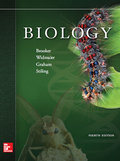
Concept explainers
Introduction: All the organisms interact with each other and with the environment to survive. The branch of science that deals with the study of the interaction of organism and nature is called ecology. Behavioral ecology is a type of ecology that studies the behavior of a species.
Answer to Problem 1TY
Correct answer: The proximate reason for the male deer fighting over females is the changes in day length. Hence, the correct answer is option d.
Explanation of Solution
Reason for correct answer:
Proximate causes are the genetic and physiological factors that influence the behavioral pattern of organisms. It has been observed that the male deer fight with each other to mate with female deer. This is because of the changes in the day length which brings hormonal changes in male deer. These are physiological changes as the male deer fight only in case of altered day length and not in the day with normal length. Therefore, the proximate cause of male deer fighting over female is changes in day length.
Option d. is given as “Because changes in day length stimulate this behavior”.
The changes in day length stimulate behavior that causes the male deer to fight over females. Hence, the correct answer is option d.
Reasons for incorrect answer:
Option a. is given as, “To determine their supremacy over other males”.
Proximate causes occur due to genetic and physiological factors. The determination of supremacy over other males is a social factor. It does not show any genetic or physiological pattern. Determining supremacy is not a proximate cause of male deer fighting over females. Hence, option a. is incorrect.
Option b. is given as, “To injure other males so that those males cannot mate with the females”.
The proximate causes include two factors, namely genetic and physiological. Any attack on male deer to reduce their mating chances is not a proximate cause as it does not include any genetic or physiological factor. Hence, option b. is incorrect.
Option c. is given as, “To maximize the number of genes the male deer pass on”.
Proximate causes include genetic and behavioral factors. The number of genes is a genetic factor. However, maximizing the gene number cannot be achieved by male deer fighting over females. Hence, option c. is incorrect.
Option e. is given as, “Because fighting helps rid the herd of weaker individuals”.
The fighting of males to get rid of weaker individuals cannot be a proximate cause. This is because, it does not include any genetic or physiological factors. Hence, option e. is incorrect.
Hence, the options a., b., c., and e. are incorrect.
Therefore, the proximate cause of the male deer fighting over the female deer is changes in day length.
Want to see more full solutions like this?
Chapter 55 Solutions
EBK BIOLOGY
- What symbolic and cultural behaviors are evident in the archaeological record and associated with Neandertals and anatomically modern humans in Europe beginning around 35,000 yBP (during the Upper Paleolithic)?arrow_forwardDescribe three cranial and postcranial features of Neanderthals skeletons that are likely adaptation to the cold climates of Upper Pleistocene Europe and explain how they are adaptations to a cold climate.arrow_forwardBiology Questionarrow_forward
- ✓ Details Draw a protein that is embedded in a membrane (a transmembrane protein), label the lipid bilayer and the protein. Identify the areas of the lipid bilayer that are hydrophobic and hydrophilic. Draw a membrane with two transporters: a proton pump transporter that uses ATP to generate a proton gradient, and a second transporter that moves glucose by secondary active transport (cartoon-like is ok). It will be important to show protons moving in the correct direction, and that the transporter that is powered by secondary active transport is logically related to the proton pump.arrow_forwarddrawing chemical structure of ATP. please draw in and label whats asked. Thank you.arrow_forwardOutline the negative feedback loop that allows us to maintain a healthy water concentration in our blood. You may use diagram if you wisharrow_forward
- Give examples of fat soluble and non-fat soluble hormonesarrow_forwardJust click view full document and register so you can see the whole document. how do i access this. following from the previous question; https://www.bartleby.com/questions-and-answers/hi-hi-with-this-unit-assessment-psy4406-tp4-report-assessment-material-case-stydu-ms-alecia-moore.-o/5e09906a-5101-4297-a8f7-49449b0bb5a7. on Google this image comes up and i have signed/ payed for the service and unable to access the full document. are you able to copy and past to this response. please see the screenshot from google page. unfortunality its not allowing me attch the image can you please show me the mathmetic calculation/ workout for the reult sectionarrow_forwardIn tabular form, differentiate between reversible and irreversible cell injury.arrow_forward

 Biology (MindTap Course List)BiologyISBN:9781337392938Author:Eldra Solomon, Charles Martin, Diana W. Martin, Linda R. BergPublisher:Cengage Learning
Biology (MindTap Course List)BiologyISBN:9781337392938Author:Eldra Solomon, Charles Martin, Diana W. Martin, Linda R. BergPublisher:Cengage Learning Biology: The Dynamic Science (MindTap Course List)BiologyISBN:9781305389892Author:Peter J. Russell, Paul E. Hertz, Beverly McMillanPublisher:Cengage Learning
Biology: The Dynamic Science (MindTap Course List)BiologyISBN:9781305389892Author:Peter J. Russell, Paul E. Hertz, Beverly McMillanPublisher:Cengage Learning





